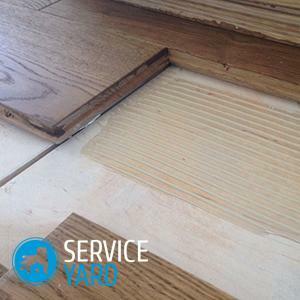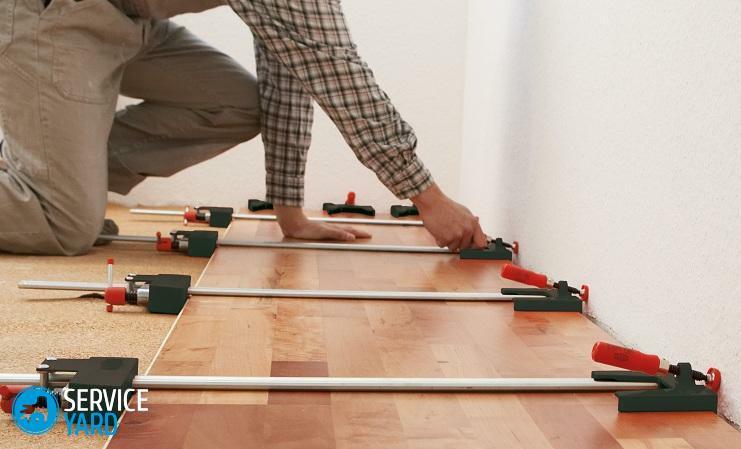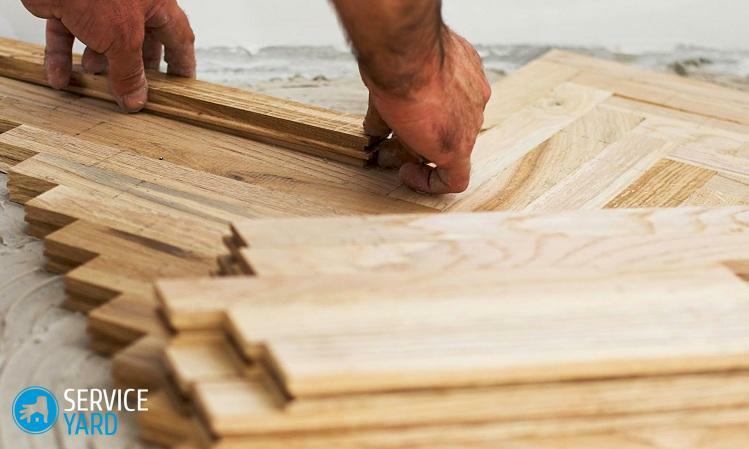
- Variety of parquet board
- Features of laying parquet boards
- How to prepare the base for laying parquet?
- Features of laying a parquet board in different ways
People wishing to emphasize their high status, good taste and wealth, choosing a floor covering, usually prefer parquet. And all because this material has an excellent wear resistance, a high level of reliability, it is environmentally safe and looks just chic. The most problematic moment and complex variety of work has always been considered a parquet flooring. But fortunately, with the advent of the parquet board, the situation has changed for the better, and even a novice builder or a person far from repair work can cope with this work. Today we will study how to lay a parquet board yourself, guided by the recommendations and advice of specialists.
to the contents ↑Varieties of the
parquet board Today, this material is produced in several variations. In the market there are multilayered and massive parquet boards. Their main difference lies in the way of manufacturing. And, depending on the mode of production, they are divided into:
- Massive boards - produce from solid pieces of hardwood and softwood. They are fastened with the help of ridges and grooves located at the ends of the boards. Such materials are expensive because they are used to make huge pieces of the most expensive wood.
- Multilayer boards - two or three layers of wooden sticks glued together. To give them additional strength, in the production process, the layers are stacked on each other only at a right angle. But they have such unique performance characteristics due to the use of different types of wood. So, the top layer, as a rule, produces from the hardest tree species, and the second layer is made of softer wood. The subsequent layers are formed already from plywood or previously discarded slats of pine or spruce. Such boards are much cheaper than massive ones, because they are made for materials of smaller sizes.
Depends on the number of slats, parquet boards also can be different. Namely, single-band, two-band, three-band and even four-band. To understand what better materials to choose, you need to know the following:
- The most popular are the three-lane boards, because they are most similar in appearance to the parquet and are inexpensive.
- The most budget option is parquet boards, consisting of four strips, because they are made from the narrowest slats. Unfortunately, their unattractive appearance does not allow to realize the designers' ideas due to a successful combination of lamellas.
- Most expensive are single-lane and two-lane boards, because they are produced from the widest pieces of expensive wood. The room with such a floor looks solemn and rich.
Important! In thickness, they can also be different from 7 to 22 mm. And it is this parameter that directly determines how the board will fit.
to the contents ↑Features of laying parquet boards
Despite the fact that the installation of a parquet board can even be performed by a novice, there is still a risk of completely ruining the coating. Therefore, in the course of the work, you need to adhere to a certain styling technology.
If you want your parquet floor to last as long as possible, then be sure to follow the rules below:
- The foundation must be qualitatively prepared. To do this, it is necessary to create an even and strong surface, without any changes and deep cracks.
- The necessary humidity level must be maintained. Though due to modern technologies the wood is reliably protected from moisture, it is still not recommended to put this material on the floor in the bathroom, kitchen and toilet, because this is where the highest humidity level prevails.
- The parquet board should be well prepared for laying. So that after the completion of all the works it does not begin to warp and crack, you should leave it right after the purchase in the room where it will be packed for several days.
Important! Observe a certain level of humidity and temperature regime is necessary during the installation. Take care that the temperature does not drop below 18 degrees, and the humidity is maintained at 35-65%.
- The board must also be insulated, because it is particularly susceptible to negative effects of moisture and temperature. For this purpose, a substrate is provided, which consists of a layer of thermal insulation and waterproofing.
- Choose the right direction of laying. The boards must be placed in the direction of the sun's rays, so that the joints are almost invisible.
- If in the house where you want to put parquet, the system of the warm floor works, then you will have to create a separate covering from the boards for each room. The fact is that in each room its temperature microclimate and therefore the temperature can fluctuate in large limits.
How to prepare the base for laying parquet?
Before learning how to properly lay the parquet board, read the information that relates to the implementation of mandatory preparatory work. This refers to the base on which the styling will be performed.
Important! Mounted parquet board can be on a concrete, and on a wooden base. Therefore, it is important that they are even and strong. If you create floors from scratch, then they will have to do with the future laying of the parquet. If you have to work with the old floor, you will need to make repairs and a complete audit.
Features of the preparation of the wooden base
If you want to use the existing wooden floor as a basis, then you will need to perform a number of works before putting the parquet board:
- . First you need to remove the old covering and check that the floor does not creak anywhere andFailed, there were no crevices between the boards and all the elements were firmly attached.
- If problems are not identified, then you can start laying. Otherwise - it is necessary to work well in case of detection of any defects.
Important! If you just dried the floorboards and there were big differences between them in height, you can level the floor with a putty or otsiklevat it. And if they just loosened, then with the help of self-tapping screws they can be attached to the lags.
- The most difficult and time-consuming process is the restoration of damaged logs. The fact is that in such a situation it will be necessary to completely disassemble the floor. The sagging lags can be raised by placing wooden chips or bars under them. And rotten boards definitely have to be replaced.
- Maximum attention should be paid to the level of the lag. It is necessary to check that all of them are in the same plane along the horizon.

Preparation for laying the foundation of concrete
Here everything is much simpler and the work is less. Perform the following actions:
- Remove the old coating and check for any breaks, cracks or irregularities. If everything is good, and there are small irregularities and cracks, then you can top them with a primer, pour a special screed, which itself is leveled after drying.
- If the concrete floor has crumbled, then with the help of a puncher remove the old screed and reinstall it again. And only after that it will be possible to start working with parquet.
Features of laying a parquet board in different ways
And now we will consider how to lay a parquet board with your own hands in all possible ways. To date, there are three:
- floating method;
- with fasteners;
- by means of glue.
Important! At once it should be noted that:
- Floating and gluing methods require the creation of a solid base for laying the parquet. As a rule, they are used in cases when working with panels of any type and thickness.
- By means of fastening boards are laid directly on the logs or wooden base - in this case it is very important that the board is at least 20-22 mm thick.
To choose the best option for yourself and learn the features of the installation, you need to read each way separately.
Parquet flooring by floating method
This option is considered the fastest, easiest and does not require much effort. In this case, the boards are placed directly on the substrate, and the panels are connected to each other in the lock. And now it is more detailed how to lay the parquet board in a floating way:
- We lay the waterproofing on the already prepared base. Use for this purpose a polyethylene film with a thickness of 200 microns. So that in the end you get a solid surface, you should overlap the film overlapping next to each other, so that the admission is 15-20 cm. Then they are glued together with adhesive tape. It is necessary to make a 10-15 cm clearance on the walls.
- The second layer is a substrate laid on top of the film. As a substrate, foam polyethylene or a plug can be used. To stack them it is necessary buttock. All the cracks and joints will need to be pasted with adhesive tape.
- Before laying the board itself, you need to calculate the required amount of material. We do this so that, if necessary, cutting the last row, its width does not exceed 5 cm.
- Now we connect the panels of the first row and lay them with a spike directly to the wall. To ensure a close fit of the boards to the wall, you need to cut the spikes.
Important! In order to avoid damage and swelling of the boards due to fluctuations in humidity between seasons, you should leave clearances of 10-15 mm between the boards and walls. And that they are preserved, it is necessary to drive pegs.
- Panels of the second row are connected first, and then completely the whole row is completely attached to the first. Through the wooden block you need to finish the boards with a hammer.
- Begin laying the third row from the board, the length of which is ⅓ part of the normal panel.
- The fourth row begins with a whole board. All the remaining series are stacked according to the same scheme.
- After laying the last panel, it is necessary to remove the piercing pegs and install a skirting board.
Important! Often, when performing work of this nature, there are problems associated with circumvention of water pipes and heating pipes. To ensure that the coverage in these places is ideal, you need to carefully cut the parquet board. As for the doorway, then just make a markup and cut the panel in the form of a rectangle.

Parquet gluing
The installation of a parquet board in this way allows you to create a stronger monolithic structure, but you will have to work hard. In this embodiment, all the actions take place in the same sequence as in the method described above. But there are some differences:
- In case of working with glue, the waterproof plywood will play the role of the substrate, which should be put in rows in a run-off. It must be additionally fastened to the base with screws or special pneumatic nails.
- Apply adhesive to the substrate and boards using a notched trowel. Also fill them with all grooves on the ends of the panels. Remove excess glue with a damp cloth.
Important! The only drawback of this method is the high labor costs and the complexity of laying.
Fixing method for laying parquet boards
Use this method when laying parquet on logs. In principle, most of the work is done in a similar way to previous methods. But, naturally, some differences are present:
- Use this method in cases of laying massive and multilayered parquet boards with a thickness of 20 mm.
- Apply laying with fasteners also when laying massive boards is made on a solid wooden surface or on logs.
- At the stage of installing the lag, waterproofing and insulation are carried out.
- The boards are attached by nailing the nails into a groove at an angle of 45 degrees or screwing the screws.
Important! In the process of laying the log, it is necessary to follow that the joints of the boards passed right in the middle of the lag. And nails and screws must be at least 2 times longer than the thickness of the panels.
It is not so important which way you prefer, the main thing is to do everything carefully, following the recommendations of specialists and adhering to the technology.
